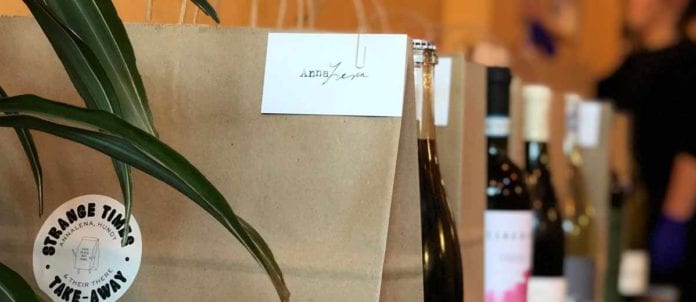Interview With Mike Robbins By Danielle Schalk
What have been the immediate impacts to your restaurant since COVID first hit, when government made it mandatory to shut down business?
We have AnnaLena, but we also have Their There and Hundy, our café and our burger restaurant. So, for them it was a little bit easier — we did takeout only and it was very straightforward because they already had offerings available for takeout; we just lost the inside seating. AnnaLena was a trickier one [and took time to reassess].
Did you have to lay off any staff? If so, how many?
We only have 15 per cent of our staff right now. We had 60 people and now we have 10.
Were you able to pivot to takeout and delivery or other different revenue streams?
We moved AnnaLena to Their There and started a new concept called Strange Times [Take Away], which encompasses all three brands out of one house. The week before [closures were mandated] I knew we were going to [close AnnaLena] whether or not it was mandated…I started working on that transition concept and, as soon as we got close enough, I just closed and started moving everything up to Their There and reorganizing it; then we launched [Strange Times].
We spent a week to two weeks prepping the concept before the city mandated we close. Basically, once Seattle got shut down, I knew that eventually we would.
What was your strategy?
The strategy behind putting everything in one house is to get AnnaLena cleaned up and organized. [Plus] then we don’t need cleaners for both places every night; we don’t need opening and closing staff at two venues. We know we’re going to do decreased revenues, so by putting everything out of one house and branding the whole thing out of one space, it decreases a lot of expenses. We wanted a way to express that we have three brands operating at the same time out of one venue, so a rebrand felt necessary.
We use Resy, the reservation system [used at] AnnaLena, and we’re [scheduling] pickups for [a limited] amount of guests each night. So, you make a reservation — just like you were going to come for dinner — but you just come in to pick up your meal. We coordinate those pickup times and control them through call-ins and Uber Eats and DoorDash, [et cetera].
To date, what have been the challenges and the opportunities of this pivoting?
The food you cook at a restaurant like [AnnaLena] doesn’t translate really well in a takeout box. So, you need to rethink what food travels well — considering it’s in a box for 20 minutes or half an hour — and will still be good on the other side.
Getting that organized and then figuring out how to market and execute three operations in one space is a tight kitchen, but we can use the floor because we don’t need the floor for guests.
The biggest challenge is it [being] an overwhelming event. I would never want this to happen to my business or anyone else’s, but it happened and it’s a new time. I always enjoy challenges…it’s an expensive one and it’s nerve-racking and edgy and there are so many questions we don’t know the answers to, but there’s still something intriguing about navigating through this time and preparing to relaunch and seeing if you can survive.
I won’t go into detail, but we’re re-inventing AnnaLena, for what we’re hoping is the better. And it’s something we never would have done without this happening.
What lessons have you and your team learned through this process?
[There’ve been] hundreds. Through anything like this you’re going to learn, just through challenging yourself.
Based on expected changes or reductions in business, how do you anticipate your business may change moving forward?
AnnaLena, is going to have to still maintain a strong takeout presence moving forward. So, then you’re in this weird place where you need a menu that packs well and can be takeout, but you also want to have really nice food for people that are still coming in. So, [on one hand], we need to dumb down the menu and, on the other, we want to increase the quality. There’s lots of questions; we’re finding the answers slowly.
I don’t know how much the other [concepts] are going to change in that sense, because they were pretty close to what they are now. [They’ll] just be even more takeout friendly and probably [have] a lot more retail available, but nothing too crazy. When you minimize seats, you acquire more space to do other things with and it’s important that people do other things with the excess space…You need to fill that space with something that generates money.
What’s your advice to other operators?
My advice would be [to do] the things I’m doing. I don’t have an answer as to whether or not they’re the right decisions. It’s survival mode, but I still want to survive at least doing some of the things I want to do for a living. Some people are enjoying the process of turning their cafés into grocery stores, but I don’t want to own a grocery store, so I don’t want to do that.
During this time, we’ve seen a lot of companies and businesses step up to help the greater community.
Have you introduced any initiatives on this front? If so, please describe impact?
We’ve made donations to the hospitals and food bank.


















